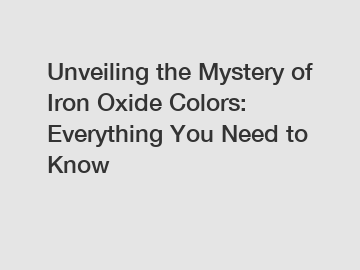Unveiling the Mystery of Iron Oxide Colors: Everything You Need to Know
Yayang contains other products and information you need, so please check it out.
Unveiling the Mystery of Iron Oxide Colors: Everything You Need to Know?
Iron oxide colors have fascinated scientists, artists, and enthusiasts for centuries. These vibrant pigments not only brighten up our world but also hold hidden secrets that continue to captivate our imagination. In this article, we will delve deep into the realm of iron oxide colors, uncovering their origins, properties, applications, and much more.

1. What are Iron Oxide Colors?
Iron oxide colors, commonly referred to as rust or ochre, are naturally occurring pigments derived from iron and oxygen. They exist in various forms, each with its own unique chemical composition and color. The three primary types of iron oxide colors are:
- Red Iron Oxide (Fe2O3): Known for its vivid, warm red color, red iron oxide is the most common among the iron oxide pigments. It can be found naturally in the earth's crust or manufactured synthetically.
- Yellow Iron Oxide (FeO(OH)): Yellow iron oxide, also known as yellow ochre, boasts a delicate golden hue. It occurs as a mineral, but it can also be produced in a lab to ensure consistent quality.
- Black Iron Oxide (Fe3O4): Black iron oxide, also called magnetite, features a deep, intense black color. It occurs naturally as an iron-rich mineral and can also be produced synthetically.
2. The Origins of Iron Oxide Colors.
Iron oxide colors have a long and fascinating history. They have been used by humans for thousands of years, dating back to ancient civilizations. In nature, iron oxide pigments form when iron-containing minerals come into contact with water and oxygen. Over time, these minerals undergo a chemical reaction, resulting in the formation of iron oxide compounds.
3. Properties and Uses.
Iron oxide colors possess several remarkable properties that make them highly desirable for a wide range of applications:
- Stability: Iron oxide pigments showcase exceptional stability and resistance to fading even when exposed to harsh environmental conditions. This makes them ideal for outdoor applications such as coatings, paints, and construction materials.
- Heat Resistance: Iron oxide pigments can withstand high temperatures without losing their color integrity. This makes them suitable for applications in ceramics, refractory materials, and even cosmetics.
- Non-Toxicity: Iron oxide colors are considered safe and non-toxic, making them widely used in various industries, including the manufacturing of cosmetics, food and drug coloring, and children's art supplies.
The diverse applications of iron oxide pigments include:
- Architectural and Industrial Coatings: Iron oxide pigments are extensively used in the production of paints, coatings, and stains. They provide not only vibrant and long-lasting colors but also protection against corrosion and UV damage.
- Construction Materials: Iron oxide pigments are crucial in the construction industry, providing coloration to concrete, pavers, bricks, and other construction materials. They enhance the aesthetic appeal and durability of these products while withstanding the test of time.
- Plastics, Rubber, and Textiles: Iron oxide colors are widely employed as colorants in plastics, rubber, and textiles industries. They offer excellent dispersion, heat resistance, and compatibility with various polymers, making them perfect for imparting vibrant and stable colors to these materials.
4. Production Methods.
Iron oxide pigments can be obtained through both natural and synthetic methods:
- Natural Extraction: Iron oxide pigments can be extracted from naturally occurring iron-rich minerals such as hematite, goethite, and magnetite. These minerals are mined, crushed, purified, and processed to obtain the desired pigment.
- Chemical Synthesis: Synthetic iron oxide pigments are manufactured through chemical reactions that involve the precipitation of iron salts and subsequent oxidation. This method ensures consistent quality, purity, and color control.
5. Environmental Impact.
Iron oxide colors are considered environmentally friendly due to their low toxicity and non-reactive nature. They are not known to cause harm to ecosystems or human health when used responsibly. Furthermore, the production of iron oxide pigments can be environmentally sustainable, utilizing eco-friendly extraction techniques and reducing waste.
In conclusion, iron oxide colors have a rich history, remarkable properties, and extensive applications across various industries. From their natural origins to modern manufacturing processes, these pigments continue to captivate us with their vibrant hues and versatility. Whether it is adding a splash of color to our surroundings or ensuring longevity and protection, iron oxide colors have undoubtedly left an indelible mark on our world.
Please visit our website for more information on this topic.
The company is the world’s best attapulgite powder manufacturer supplier. We are your one-stop shop for all needs. Our staff are highly-specialized and will help you find the product you need.



